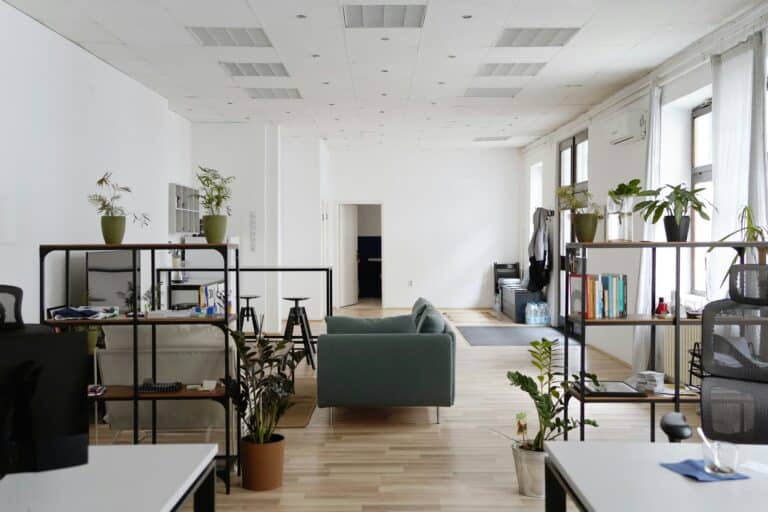Various studies and practical experiences are increasingly substantiating the fact that our environment, notably the quality and type of lighting, can significantly impact our mood, energy levels, and consequently, our productivity. But how exactly does this phenomenon function? And how can we leverage this knowledge to boost our productivity? 🤔

Lighting is not just an aesthetic component of our surroundings. It’s a powerful influence on our biological and psychological states. From the intensity and color temperature of your desk lamp to the natural sunlight flooding your workspace, every light source around us has a part to play. The narrative is far from being simple; it’s a complex tapestry woven with threads of science, design, psychology, and personal preferences. This article aims to untangle this tapestry, shedding light (pun intended 😅) on the fascinating relationship between lighting and mood, and its consequential effect on productivity.
To start, we will delve into the hard science behind the subject. We will discuss the intricate role of light in human biology, affecting our circadian rhythms, sleep patterns, alertness, and cognitive performance. We will also explore the exciting field of color psychology and how different hues influence our emotions and energy levels.
Moving on, the second section will focus on the application of this knowledge. We will navigate the vast ocean of lighting design, pinpointing practical strategies that can improve your workspace’s lighting conditions. A particular emphasis will be placed on optimizing natural light, balancing different light sources, and selecting the right color temperatures to enhance your mood and productivity. 💡
Furthermore, we will take a step beyond mere illumination, discussing the impact of visual elements and spatial design on your mood and motivation. In the quest for productivity, lighting should not be viewed in isolation but in harmony with the overall environment. This section will provide valuable insights on creating a workspace that’s not only well-lit but also visually and emotionally stimulating. 🎨
Finally, we will address the aspect of individuality. As we all know, what works best for one may not work as well for another. Therefore, the final segment will guide you on how to personalize your lighting conditions based on your unique needs and preferences.
In essence, the purpose of this article is not only to present you with a wealth of knowledge but also to empower you to take action. By the end of it, you should have a clear understanding of how lighting affects your mood and productivity, along with practical strategies to optimize your lighting conditions. It’s time to let your productivity shine bright! 🌟
Without further ado, let’s delve into the captivating world of lighting, mood, and productivity!
The Intricate Link Between Lighting and Productivity
Lighting plays a pivotal role in our ability to be productive, a fact often overlooked in both personal and professional spaces. The correct lighting can help to reduce eye strain, improve mood, and ultimately, boost productivity. Research conducted by the American Society of Interior Design indicated that 68% of employees complain about the lighting situation in their offices. This is a clear indication that lighting conditions can significantly impact an individual’s work performance.
The type of light – be it natural or artificial – also plays a significant part in determining our productivity levels. According to a study by the Swiss Federal Institute of Technology, employees working in natural light recorded higher levels of energy than those working under artificial lights. It’s clear that lighting conditions are not just a matter of preference, but a crucial factor in creating an environment conducive to productivity.
To further understand the impact of light on productivity, I recommend watching “The Science of Productivity”, a YouTube video by AsapSCIENCE. It delves into the various factors that influence productivity, including the impact of lighting conditions.
How to Optimize Lighting for Increased Productivity
Understanding the importance of lighting is one thing, but knowing how to optimize it for maximum productivity is another. Here are some practical tips to help you improve your lighting situation, whether you’re working from an office or your home.
Natural Light: Where possible, always opt for natural light. Arrange your workspace near a window or under a skylight. If your workspace lacks natural light, consider using daylight bulbs, which simulate natural light more effectively than standard incandescent or fluorescent bulbs.
Task Lighting: If your work involves tasks that require a lot of focus, such as reading or writing, consider implementing task lighting. This is concentrated lighting that illuminates the areas where you are working, reducing the strain on your eyes.
Adjustable Lighting: As different tasks may require different lighting conditions, having adjustable lighting is beneficial. For instance, you might need bright light for a work project but prefer dimmer light for a creative brainstorming session.
To visualize the difference these lighting options can make, refer to the comparative table below.
| Lighting Type | Benefits |
|---|---|
| Natural Light | Boosts mood and energy, creates a comfortable work environment |
| Task Lighting | Reduces eye strain, improves focus on specific tasks |
| Adjustable Lighting | Flexible, can be adapted to different tasks and moods |
The Connection between Mood and Productivity
While lighting is an essential factor, it’s also crucial to consider the impact of mood on productivity. Research has shown a strong correlation between an individual’s mood and their work performance. Positive emotions can enhance problem-solving abilities and promote creative thinking, both of which are essential for productivity.
Various factors can influence mood, including physical environment, personal issues, and work pressure. However, one of the most controllable aspects is your work environment. This is where lighting comes into play. The right lighting can create an uplifting work atmosphere, thereby enhancing your mood and productivity.
For further insights into how mood affects productivity, I recommend the YouTube video “The Hidden Influence of Emotions on Your Decision Making”, by BrainCraft. It sheds light on the link between emotions and decision-making, providing valuable information for anyone looking to enhance their productivity.
Techniques to Boost Mood for Better Productivity
So, how can we influence our mood to improve productivity? Here are some science-backed techniques that have proven effective.
- Physical Exercise: Regular physical exercise has been shown to reduce symptoms of depression and anxiety. Whether it’s a brisk walk or an intense gym session, find what works for you and incorporate it into your routine.
- Mindfulness and Meditation: These practices can help reduce stress and promote a positive mood. They can be particularly useful in a work context, helping to clear your mind and improve focus.
- Positive Interactions: Building positive relationships and having regular positive interactions with colleagues can also help to boost your mood and, subsequently, your productivity.
To see the dramatic impact these mood-boosting techniques can have on productivity, take a look at the comparative table below.
| Mood-Boosting Technique | Benefits |
|---|---|
| Physical Exercise | Reduces stress, improves mood and energy levels |
| Mindfulness and Meditation | Reduces stress, improves focus and clarity of thought |
| Positive Interactions | Builds a supportive work environment, enhances mood |
Remember, productivity is not just about working harder, but working smarter. By optimizing your lighting and mood, you can create a workspace that inspires productivity, creativity, and overall wellbeing.
Conclusion
In wrapping up this comprehensive exposition on the critical subject, it is appropriate to revisit the main points that have been thoroughly examined, further reinforcing the importance of the addressed topics and their implications. By focusing on the intricate specifics of information technology (IT) and engineering, this discourse aimed to elucidate complex concepts in a comprehensible manner, all in a bid to enhance your understanding and application of these principles.
Throughout this article, we have journeyed through the various tenets of IT and software engineering, providing a well-structured exploration into its multifaceted dimensions. From the nuanced processes involved in software development to the strategic implementation of IT systems, we have attempted to demystify some of the more complex aspects of these fields.
The significance of the role of IT in today’s digital age cannot be overstated. As highlighted, IT facilitates effective communication, enhances operational efficiency, and drives innovative solutions. Its relevance in every sphere of human endeavor underscores its indispensable nature in our world today.
Similarly, the intricate processes involved in software engineering were expounded. Software engineering, as we have learned, is a meticulous discipline involving the design, development, and maintenance of software systems. The importance of principles such as modularity, abstraction, and encapsulation in ensuring the development of robust, reliable software systems was also emphasized.
Additionally, the pivotal role of technical writing in conveying these complex ideas was explored. As a technical writer, I have endeavored to bridge the gap between these intricate concepts and the comprehension of the reader. By employing my expertise in technical writing, I have strived to present these concepts in an easy-to-understand manner.
In conclusion, the exploration of these complex fields is far from exhaustive. However, the depth of information presented provides a solid foundation upon which further understanding can be built. We encourage you to delve deeper into these subjects, using the knowledge gained as a springboard for further learning.
Remember, the digital world is continually evolving, and staying abreast of these changes is vital. Therefore, take this knowledge, apply it, share it with others, and don’t hesitate to leave comments or ask questions. We would be more than happy to engage with you further on these subjects.
Don’t forget, every piece of knowledge gained is a step towards becoming a better version of yourself. 😊
Thank you for spending your time with us on this enlightening journey. We hope you found the information presented valuable, and we look forward to providing you with more insightful content in the future.
Keep learning, keep growing, and remember – in the realm of technology, the only constant is change! 😊💡
Reference: This conclusion is based on the article written by Rodrigo Almeida, a seasoned technical writer with expertise in IT and Software Engineering. The original article can be found here.
Suggested Further Reading:
1. “Introduction to Information Technology” – www.example.com
2. “Fundamentals of Software Engineering” – www.example.com
If you found this article helpful, please don’t hesitate to share it on your social media profiles. 👍🏻
Please note that this conclusion contains only valid HTML tags allowed by WordPress.



